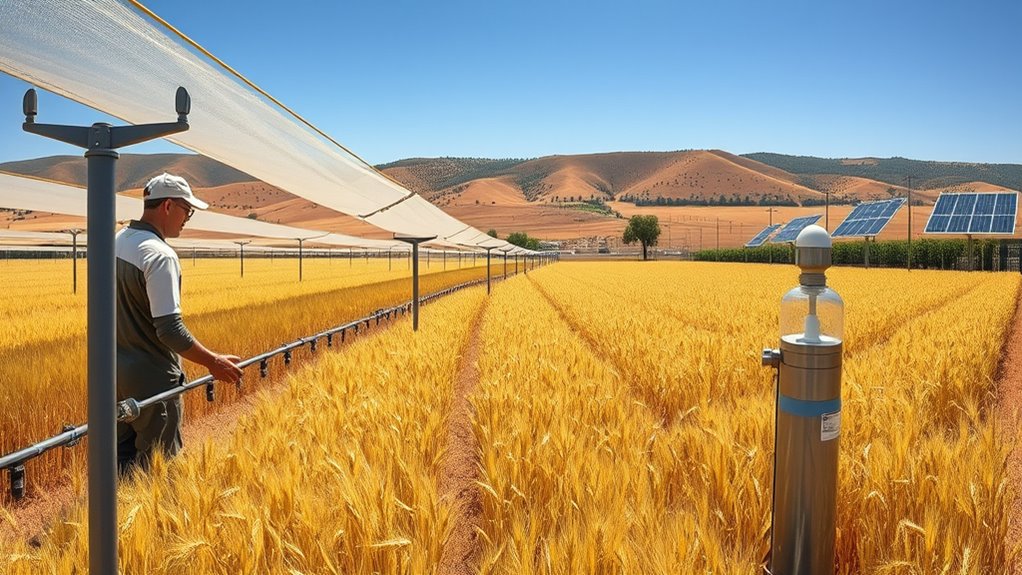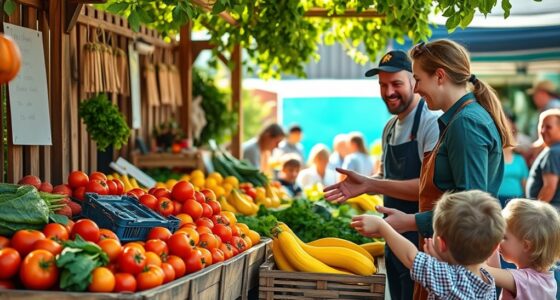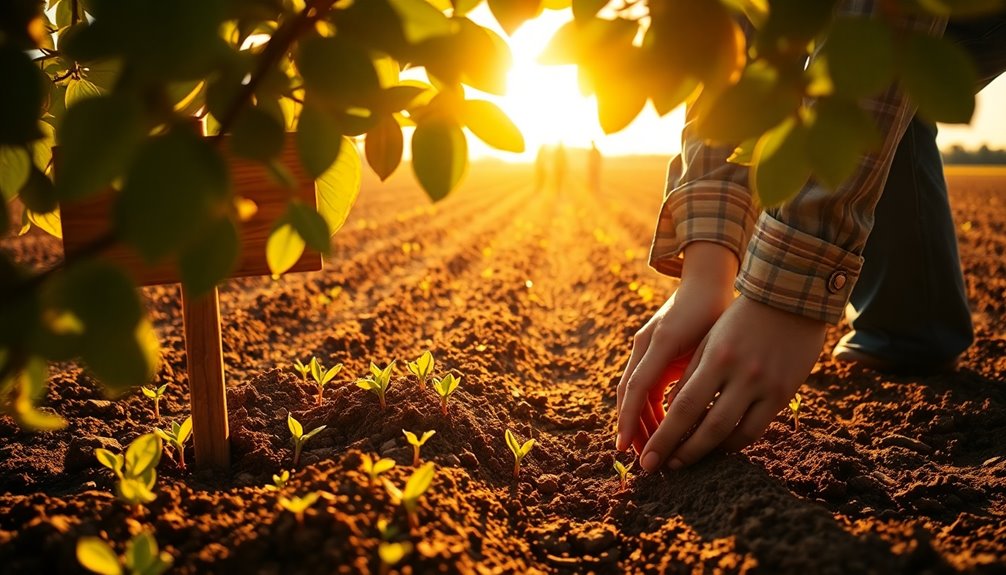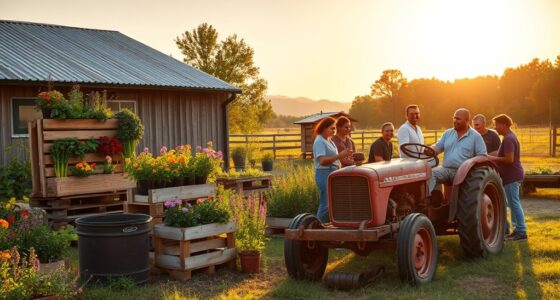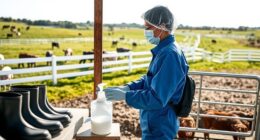To adapt to Europe’s drought challenges, consider adopting water-saving farm technologies like drip irrigation and soil moisture sensors. Drip systems deliver water directly to plant roots, reducing waste and runoff, while soil sensors help monitor moisture levels precisely. Automated controls adjust watering schedules in real time, ensuring efficient use of limited water resources. Reusing runoff and installing rainwater harvesting further boost sustainability. Keep exploring these innovations to make your farm more resilient during dry spells.
Key Takeaways
- Implementing drip irrigation and soil moisture sensors optimizes water use and reduces waste during drought conditions.
- Automated and remote control systems enable precise, timely watering, minimizing over- and underwatering risks.
- Water recycling, rainwater harvesting, and runoff reuse create resilient, sustainable water management practices.
- Advanced technologies like AI, sensors, and drones support real-time monitoring and adaptive irrigation strategies.
- Addressing adoption challenges through education, policy support, and financial incentives is crucial for widespread implementation.
The Impact of Drought on European Agriculture
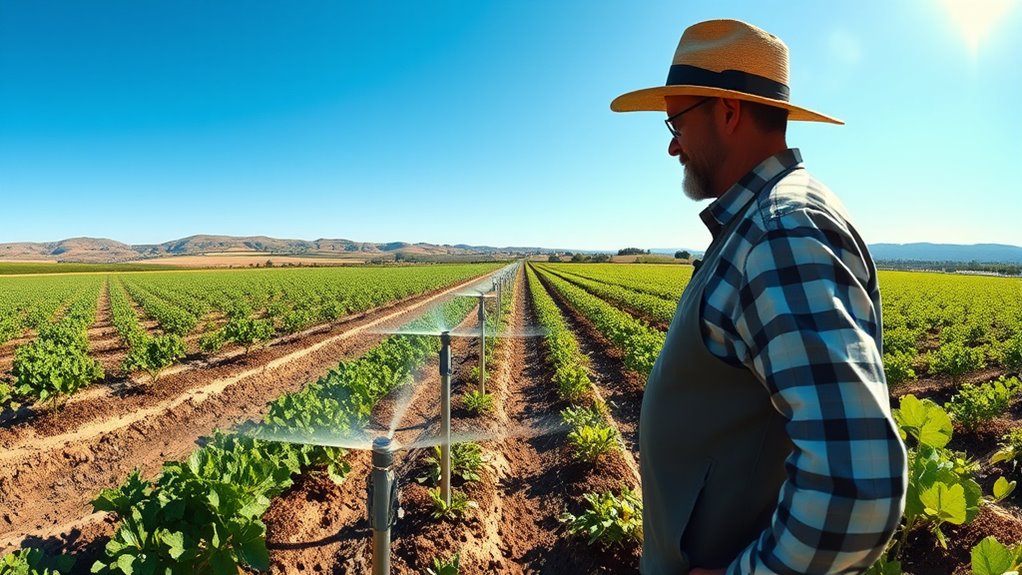
Droughts have become an increasingly severe threat to European agriculture, disrupting crop production and threatening food security across the continent. When water becomes scarce, your crops struggle to grow, leading to smaller yields and lower quality produce. This not only impacts your farm’s profitability but also affects local economies and food supplies. Drought conditions force farmers to make difficult decisions, often limiting planting or reducing irrigation, which worsens the situation. Extended dry periods also weaken soil health, making it harder to recover in future seasons. Climate change is intensifying these droughts, pushing farmers to adapt quickly. Without effective water management, the risk of crop failure rises, threatening the sustainability of agriculture across Europe. Additionally, understanding the personality traits of farm management teams can help tailor strategies for better resilience and decision-making during such crises.
Traditional Irrigation Methods and Their Limitations
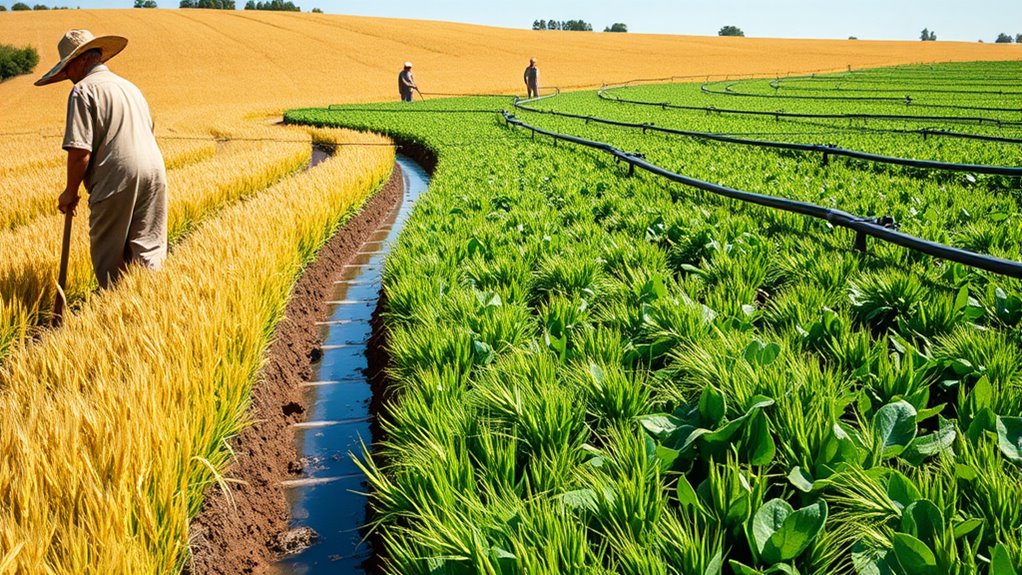
Traditional irrigation methods often lead to water wastage and uneven distribution, wasting valuable resources. These techniques can be labor-intensive, requiring significant manual effort and oversight. Understanding these limitations highlights the need for more efficient, water-saving solutions. Incorporating multi-functional equipment and vertical storage solutions can further optimize water use and improve overall efficiency.
Water Wastage Concerns
Have you ever wondered how much water gets wasted with conventional irrigation methods? Many traditional systems, like flood and furrow irrigation, deliver water indiscriminately, often soaking the soil beyond the root zone. This leads to significant runoff, evaporation, and deep percolation, which don’t benefit your crops. As a result, you’re using more water than necessary, driving up costs and straining local water resources. These methods also lack precision, making it hard to control water application levels. Overwatering can promote disease and reduce crop yields, while under-watering stresses plants. The inefficiency of these techniques not only wastes precious water but also impacts the environment. To make a real difference, you need to adopt smarter, more targeted irrigation practices that conserve water and boost productivity. Incorporating natural materials into irrigation systems can further enhance water retention and efficiency.
Inefficient Water Distribution
Why do many irrigation systems fail to deliver water efficiently? Often, it’s because traditional methods rely on manual flooding, furrows, or sprinklers that lack precision. These systems waste significant amounts of water through evaporation, runoff, and deep percolation. You might notice uneven distribution, where some areas receive too much water while others get too little. This inefficiency stems from a lack of control over flow rates and watering zones. As a result, crops don’t get the ideal amount they need, leading to stress or reduced yields. Plus, outdated infrastructure often isn’t designed to adapt to changing weather patterns or soil conditions. All these factors combine to make traditional irrigation methods far from water-smart, especially in regions facing drought conditions where every drop counts.
Labor-Intensive Processes
Many irrigation methods rely heavily on manual labor, making the watering process time-consuming and prone to inconsistency. You spend hours moving hoses, adjusting sprinklers, and monitoring moisture levels to guarantee crops receive enough water. This approach leaves room for errors, such as overwatering or underwatering, which can harm your yields and waste valuable resources. Additionally, reliance on manual labor increases costs and limits scalability, especially during peak seasons or labor shortages. Traditional methods like flood irrigation or furrow watering require significant effort and are inefficient, wasting water through runoff and evaporation. These labor-intensive processes hinder ideal water use and productivity, particularly in drought-prone regions. Transitioning to more efficient, automated systems can help you save time, reduce costs, and improve water conservation efforts. Water management techniques can further optimize resource use and enhance crop yields.
Drip Irrigation Systems: Precision Water Delivery
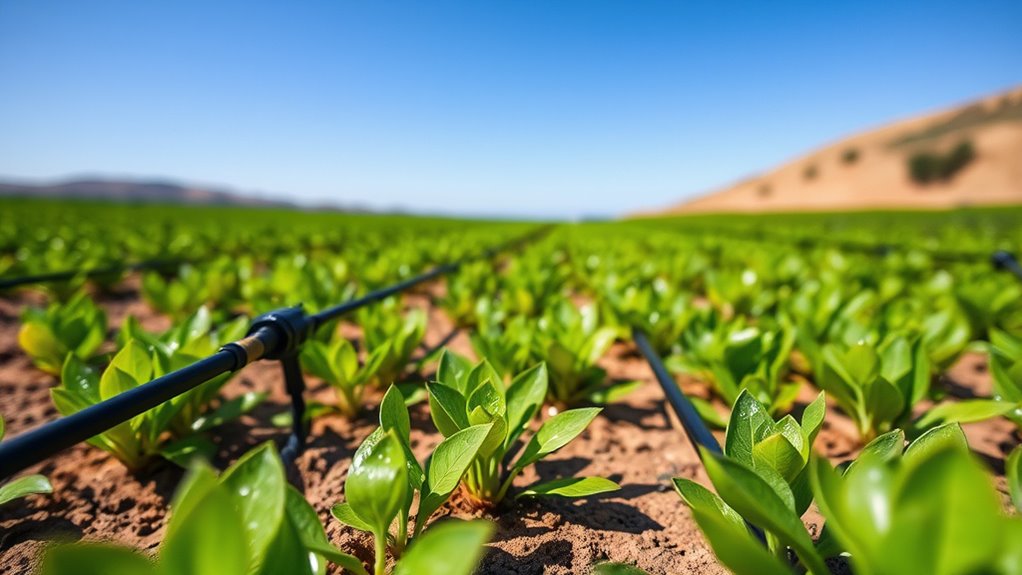
Drip irrigation systems deliver water directly to plant roots, maximizing efficiency and reducing waste. They also help control weed growth by watering only where needed, saving you time and resources. Plus, you can customize watering schedules to match your crops’ specific needs for ideal results. Using high-quality components ensures optimal water delivery and system longevity.
Water Efficiency Optimization
Have you ever wondered how farmers can deliver water more effectively to their crops? Water efficiency enhancement involves fine-tuning irrigation methods to minimize waste. Drip systems exemplify this by providing precise water delivery directly to plant roots, reducing runoff and evaporation. To boost efficiency, farmers can select appropriate emitters and adjust flow rates based on crop needs. Here’s a quick comparison:
| Feature | Benefit |
|---|---|
| Adjustable emitters | Customizes water flow for different crops |
| Soil moisture sensors | Ensures ideal watering times |
| Automated timers | Reduces human error and saves water |
Implementing crop-specific irrigation strategies can further optimize water use and improve yields.
Reduced Weed Growth
Implementing drip irrigation systems not only boosts water efficiency but also plays a significant role in reducing weed growth. Because water is delivered directly to the plant roots, weeds struggle to establish and thrive in areas with minimal surface watering. This targeted approach limits moisture in weed seed zones, preventing their germination and growth. Unlike traditional sprinklers that water broad areas, drip systems focus on crops, decreasing water availability for unwanted plants. Reduced weed presence means less competition for nutrients and sunlight, leading to healthier crops and higher yields. Additionally, the lower weed density decreases the need for herbicides, supporting more sustainable farming practices. Overall, drip irrigation helps you control weeds naturally, saving water and reducing reliance on chemical weed control methods.
Customizable Watering Schedules
How can you optimize water use on your farm? By implementing customizable watering schedules with drip irrigation systems, you gain precise control over water delivery. These systems let you set specific times and durations for watering different crops, reducing waste and ensuring each plant gets exactly what it needs. You can adjust schedules based on weather forecasts, soil moisture levels, or crop growth stages. This flexibility helps prevent overwatering and minimizes runoff. Automated timers and sensors make management easy, saving you time and effort. By tailoring water application, you improve crop health and yields while conserving this essential resource. Customizable watering schedules are a smart solution for farms facing drought conditions, helping you adapt efficiently and sustainably.
Soil Moisture Sensors and Real-Time Monitoring
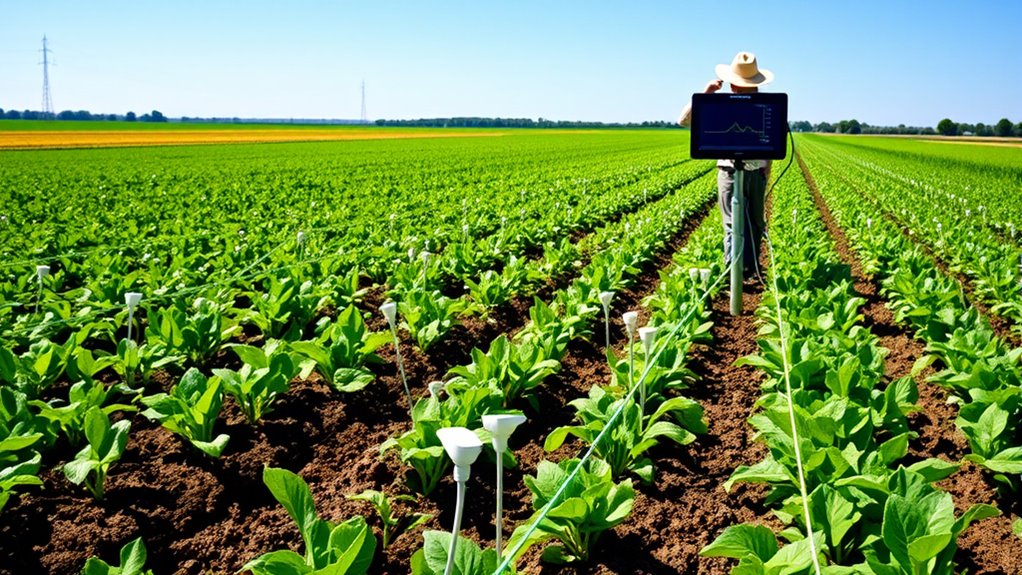
Soil moisture sensors and real-time monitoring systems enable you to precisely track water levels in your fields, ensuring ideal irrigation timing. With these tools, you get immediate data on soil conditions, helping you avoid over- or under-watering. Sensors placed at various depths provide a detailed picture of moisture levels across different zones, so you can adjust your watering accordingly. Real-time data allows you to respond quickly to changing conditions, saving water and reducing costs. You can access this information through user-friendly dashboards on your phone or computer, making it easy to monitor your fields anytime. This technology empowers you to make informed decisions, optimize water use, and maintain healthy crops despite drought pressures. Incorporating remote work principles such as real-time data access enhances your ability to manage resources efficiently and adapt swiftly to environmental challenges.
Automated Irrigation Control Technologies
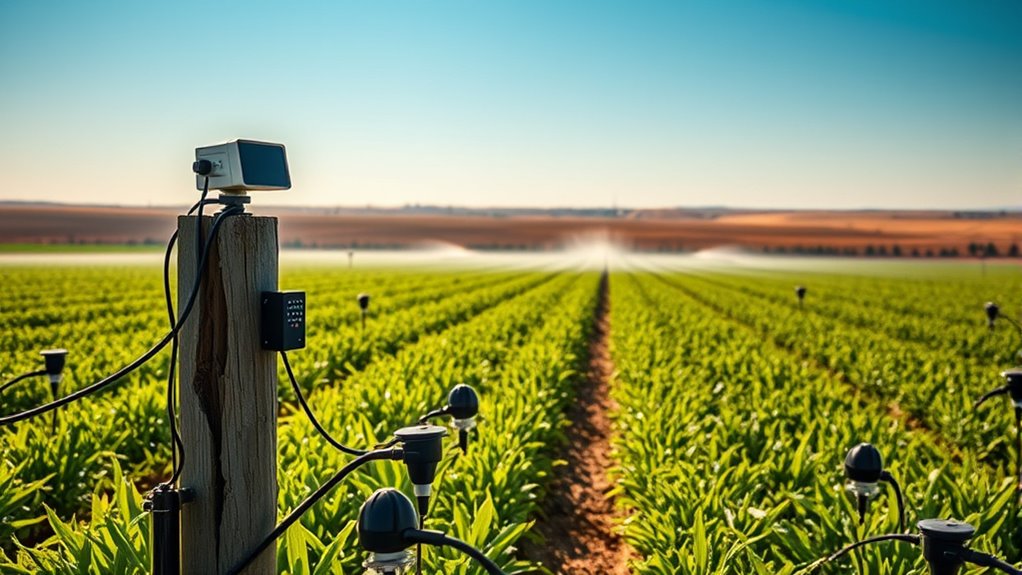
Automated irrigation control technologies use sensors and software to adjust watering schedules automatically, ensuring your crops receive the right amount of water at the right times. These systems analyze data from soil moisture sensors, weather forecasts, and crop needs to optimize watering, reducing waste. You no longer need to manually turn on or off irrigation systems, saving time and effort. By fine-tuning watering schedules, you can prevent overwatering and runoff, which helps conserve water and protect your soil. Many systems allow remote management via smartphones or computers, giving you control wherever you are. Implementing automated controls enhances water efficiency, supports crop health, and helps you adapt to drought conditions more effectively. This technology is a vital step toward sustainable and resilient farming practices. Additionally, integrating high-precision sensors can further improve the accuracy of water application, ensuring optimal conditions for crop growth while conserving resources.
Water Recycling and Reuse Strategies
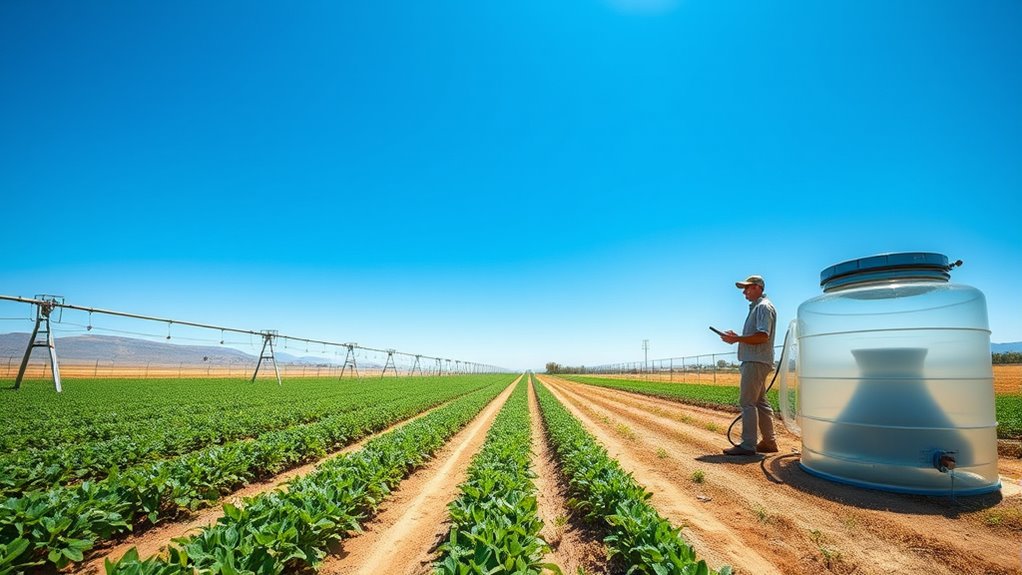
Building on the benefits of automated irrigation, implementing water recycling and reuse strategies can substantially cut your farm’s water consumption. By capturing and reusing water, you reduce dependence on external sources and boost sustainability. You might consider treating runoff water from fields or recycling wastewater to irrigate crops. These practices help conserve freshwater and lower costs over time. To maximize efficiency, focus on proper filtration and treatment systems that ensure water quality. Additionally, integrating rainwater harvesting can provide an extra buffer during dry periods. Remember, effective recycling isn’t just about saving water—it’s about creating a closed-loop system that enhances resilience and relies on water treatment technologies to maintain quality.
Adoption Challenges and Farmer Perspectives
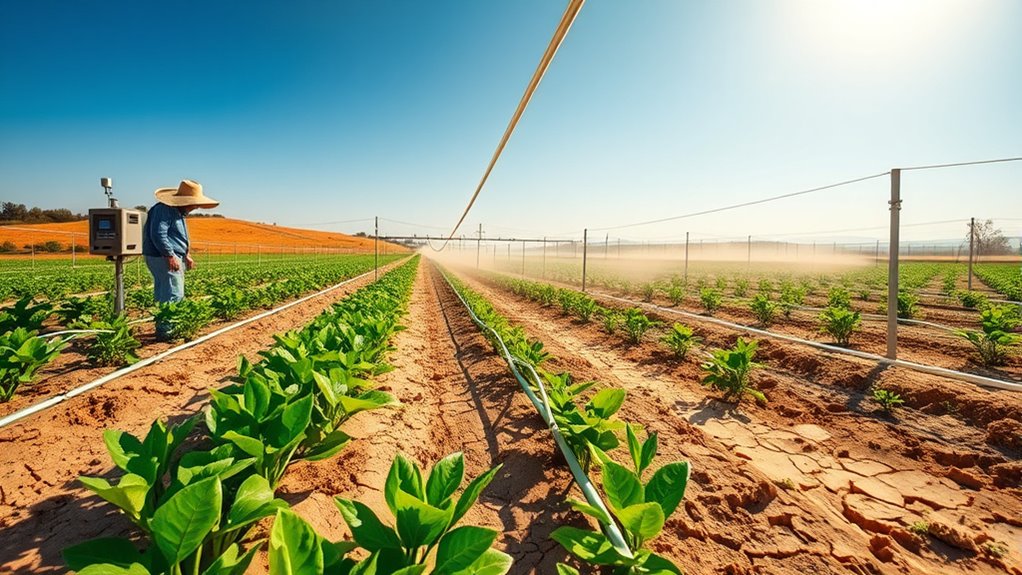
While water-saving farm technologies offer clear environmental and economic benefits, many farmers face significant hurdles in adopting them. Cost remains a primary obstacle, as new equipment and systems often require substantial upfront investment. You might worry about uncertain returns or longer payback periods, making it hard to justify the expense. Additionally, there’s often a lack of technical knowledge or training to effectively implement these solutions. Resistance to change can also play a role, especially if traditional practices have worked well over time. Policy gaps and limited access to financial incentives further slow adoption. As a farmer, you may feel uncertain about the long-term benefits versus risks, and without clear support, embracing new technology becomes an intimidating decision. Implementing robust risk management strategies can help mitigate some of these concerns.
Future Trends in Sustainable Farm Water Management
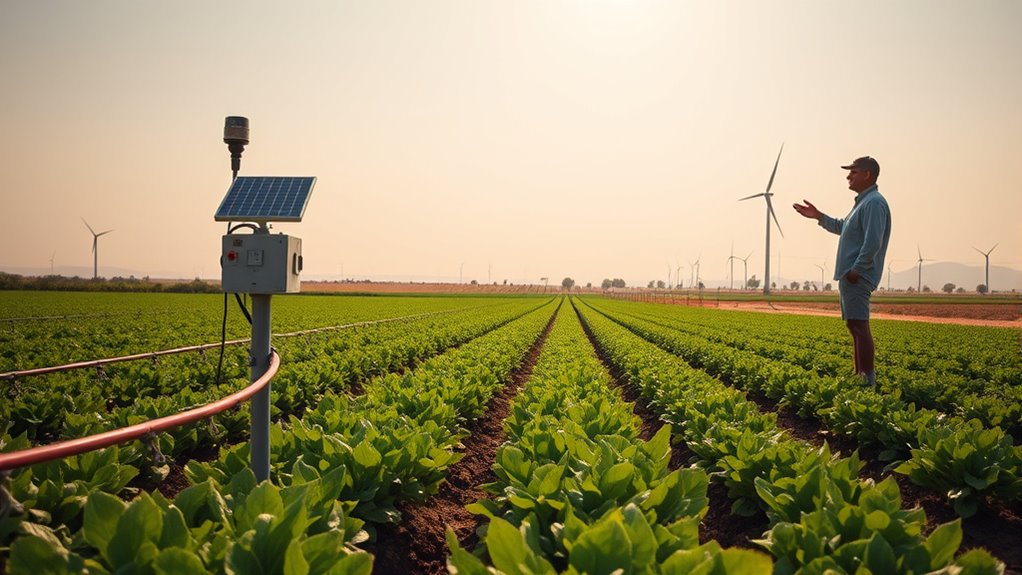
As technology advances, sustainable farm water management is poised to become more efficient and accessible through innovative solutions. You’ll see smarter irrigation systems that adjust watering based on real-time data, reducing waste and improving crop yields. Precision agriculture will integrate sensors, drones, and AI to optimize water use at every stage. Additionally, water recycling and harvesting techniques will become more prevalent, allowing farms to reuse greywater and capture rainwater effectively.
- smarter irrigation systems that adapt to weather and soil conditions
- increased use of AI and data analytics for precise water management
- expanded water recycling and harvesting methods to conserve resources
Frequently Asked Questions
How Do Government Policies Support Water-Saving Farming Innovations?
Government policies support water-saving farming innovations by providing funding, incentives, and research grants that encourage farmers to adopt new technologies. They set regulations and standards that promote sustainable water use and offer training programs to educate farmers on efficient practices. Additionally, policies often include subsidies for water-saving equipment and promote collaboration between researchers and farmers, making it easier for you to implement innovative solutions and conserve water effectively.
What Are the Economic Impacts of Adopting Water-Efficient Technologies?
You’ll see significant economic benefits by adopting water-efficient technologies; for instance, farms can reduce water costs by up to 30%. This savings boosts your profit margins and helps manage water scarcity more effectively. Additionally, investing in such innovations can improve crop yields and quality, attracting premium buyers. Although initial costs might seem high, the long-term financial gains and sustainability advantages make it a smart move.
How Do Climate Change Projections Influence Future Water Management Strategies?
Climate change projections show increasing droughts and unpredictable rainfall, so you’ll need to adapt your water management strategies accordingly. You should focus on implementing smart irrigation, rainwater harvesting, and drought-resistant crops to conserve water and guarantee sustainability. Planning for these changes now helps you mitigate future risks, protect your farm’s productivity, and comply with evolving regulations. Staying proactive allows you to effectively navigate the challenges posed by climate change.
Are There Specific Crops Better Suited for Drought-Resistant Farming?
Yes, crops like sorghum, millet, and chickpeas are better suited for drought-resistant farming because they require less water and tolerate dry conditions. You can visualize this as choosing hardy plants that thrive in tough environments, much like desert succulents. By switching to these crops, you reduce water consumption and guarantee better yields during droughts, helping you adapt more effectively to changing climate conditions and secure food production.
How Do Small-Scale Farmers Access Funding for New Irrigation Systems?
You can access funding for new irrigation systems through government grants, subsidies, and agricultural development programs. Start by researching local and national initiatives aimed at supporting sustainable farming. Reach out to agricultural extension offices or cooperatives for guidance, and consider applying for loans or grants designed specifically for small-scale farmers. Networking with other farmers can also help you discover shared resources or group funding opportunities to make upgrades more affordable.
Conclusion
By embracing water-saving farm technologies, you can turn the tide against Europe’s droughts like a captain steering through stormy seas. From drip irrigation to soil sensors, these innovations are your compass toward sustainable farming. Although hurdles exist, your proactive choices can transform challenges into opportunities, ensuring your fields thrive even in the driest times. Together, you and technology can cultivate resilience, making your farm a beacon of hope amid Europe’s water worries.

